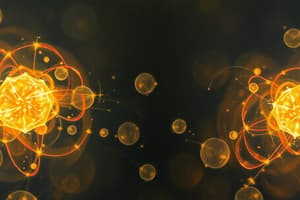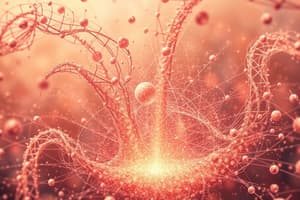Podcast
Questions and Answers
What does the kinetic theory of matter primarily explain?
What does the kinetic theory of matter primarily explain?
- The behavior of atoms in a vacuum.
- The bonding characteristics of various materials.
- The properties of solids, liquids, and gases based on particle motion. (correct)
- The chemical reactions between different states of matter.
What characteristic is unique to plasma compared to other states of matter?
What characteristic is unique to plasma compared to other states of matter?
- Plasma contains ionized particles and is electrically conductive. (correct)
- Plasma has a fixed volume and shape.
- Plasma cannot be influenced by electromagnetic fields.
- Plasma is formed only at temperatures below absolute zero.
Which of the following best describes the state of matter known as plasma?
Which of the following best describes the state of matter known as plasma?
- A liquid with properties of solid structure.
- A highly ionized gas responding to electromagnetic fields. (correct)
- A gas with a fixed volume and definite shape.
- A state at absolute zero temperature with no motion.
How is plasma commonly created?
How is plasma commonly created?
Which of the following statements about states of matter is true?
Which of the following statements about states of matter is true?
What happens to the particles of matter as temperature approaches absolute zero?
What happens to the particles of matter as temperature approaches absolute zero?
What is a common example of a plasma state in nature?
What is a common example of a plasma state in nature?
Which of these states of matter shares a property of no definite shape but may have a definite volume when confined?
Which of these states of matter shares a property of no definite shape but may have a definite volume when confined?
What is a primary characteristic of gases in terms of shape and volume?
What is a primary characteristic of gases in terms of shape and volume?
According to the kinetic molecular theory, how do gas particles behave?
According to the kinetic molecular theory, how do gas particles behave?
What happens to the pressure of a gas when its volume increases, under constant temperature according to Boyle's Law?
What happens to the pressure of a gas when its volume increases, under constant temperature according to Boyle's Law?
Why can gases be compressed easily?
Why can gases be compressed easily?
What is true about the collisions between gas particles?
What is true about the collisions between gas particles?
What occurs to a sealed bag of potato crisps when placed in a sunny window?
What occurs to a sealed bag of potato crisps when placed in a sunny window?
Which of the following best describes Boyle's Law?
Which of the following best describes Boyle's Law?
What happens to gases when temperature decreases, as related to practical examples given?
What happens to gases when temperature decreases, as related to practical examples given?
What does Gay-Lussac's law imply about gas behavior under constant volume?
What does Gay-Lussac's law imply about gas behavior under constant volume?
How is the amount of a gas expressed in scientific terms?
How is the amount of a gas expressed in scientific terms?
According to Avogadro's hypothesis, what is true about equal volumes of gases at the same temperature and pressure?
According to Avogadro's hypothesis, what is true about equal volumes of gases at the same temperature and pressure?
What volume does 1 mole of any gas occupy at standard temperature and pressure (STP)?
What volume does 1 mole of any gas occupy at standard temperature and pressure (STP)?
How does the atomic mass relate to the concept of a mole for elements?
How does the atomic mass relate to the concept of a mole for elements?
What can be inferred about the size of particles in gases according to the content?
What can be inferred about the size of particles in gases according to the content?
What assumption did early scientists make regarding larger molecules as compared to smaller molecules?
What assumption did early scientists make regarding larger molecules as compared to smaller molecules?
Which statement best describes the property of liquids compared to solids?
Which statement best describes the property of liquids compared to solids?
What is a key characteristic of solids?
What is a key characteristic of solids?
Why can't liquids be compressed significantly?
Why can't liquids be compressed significantly?
Which statement best describes the state of matter for liquids?
Which statement best describes the state of matter for liquids?
What happens to the atoms in a solid when it is heated?
What happens to the atoms in a solid when it is heated?
What is the arrangement of molecules in a solid?
What is the arrangement of molecules in a solid?
Which substance is the only metal that exists as a liquid at room temperature?
Which substance is the only metal that exists as a liquid at room temperature?
How do the forces between atoms in a solid contribute to its properties?
How do the forces between atoms in a solid contribute to its properties?
What distinguishes liquids from solids in terms of molecular arrangement?
What distinguishes liquids from solids in terms of molecular arrangement?
How do the particles in a solid behave compared to those in a gas?
How do the particles in a solid behave compared to those in a gas?
Which state of matter has the strongest forces of attraction between particles?
Which state of matter has the strongest forces of attraction between particles?
What describes the energy of the particles in a gas compared to those in a liquid?
What describes the energy of the particles in a gas compared to those in a liquid?
In which state of matter do particles have weak forces of attraction and can slide over each other?
In which state of matter do particles have weak forces of attraction and can slide over each other?
Which statement about the motion of particles in a liquid is true?
Which statement about the motion of particles in a liquid is true?
What occurs to the molecules of a substance when thermal energy is added?
What occurs to the molecules of a substance when thermal energy is added?
Which statement best describes the motion of molecules in a solid?
Which statement best describes the motion of molecules in a solid?
What happens to temperature during a phase change when energy is added?
What happens to temperature during a phase change when energy is added?
How does evaporation differ from boiling?
How does evaporation differ from boiling?
What do we call the process that requires heat energy to be absorbed?
What do we call the process that requires heat energy to be absorbed?
When energy is removed from a substance, what happens to its temperature?
When energy is removed from a substance, what happens to its temperature?
What is the primary factor that determines the degree of motion of particles?
What is the primary factor that determines the degree of motion of particles?
What phenomenon is observed when air molecules strike particles of smoke?
What phenomenon is observed when air molecules strike particles of smoke?
Flashcards
Kinetic Theory of Matter
Kinetic Theory of Matter
The theory stating that particles of matter are always in motion, above absolute zero.
States of Matter
States of Matter
Different forms that substances can exist in, including solid, liquid, gas, and plasma.
Solid
Solid
A state of matter with a definite shape and volume.
Liquid
Liquid
Signup and view all the flashcards
Gas
Gas
Signup and view all the flashcards
Plasma
Plasma
Signup and view all the flashcards
Matter
Matter
Signup and view all the flashcards
Absolute Zero
Absolute Zero
Signup and view all the flashcards
Gas State Properties
Gas State Properties
Signup and view all the flashcards
Gas Molecule Spacing
Gas Molecule Spacing
Signup and view all the flashcards
Kinetic Molecular Theory
Kinetic Molecular Theory
Signup and view all the flashcards
Boyle's Law
Boyle's Law
Signup and view all the flashcards
Elastic Collisions
Elastic Collisions
Signup and view all the flashcards
Gas Particles (Size)
Gas Particles (Size)
Signup and view all the flashcards
Gas Particle Movement
Gas Particle Movement
Signup and view all the flashcards
Pressure-Volume Relationship
Pressure-Volume Relationship
Signup and view all the flashcards
Gay-Lussac's Law
Gay-Lussac's Law
Signup and view all the flashcards
What does 'directly proportional' mean in Gay-Lussac's Law?
What does 'directly proportional' mean in Gay-Lussac's Law?
Signup and view all the flashcards
What is a mole?
What is a mole?
Signup and view all the flashcards
What is Avogadro's Hypothesis?
What is Avogadro's Hypothesis?
Signup and view all the flashcards
Why is Avogadro's Hypothesis important?
Why is Avogadro's Hypothesis important?
Signup and view all the flashcards
What is STP?
What is STP?
Signup and view all the flashcards
What defines a liquid state?
What defines a liquid state?
Signup and view all the flashcards
Liquid Properties
Liquid Properties
Signup and view all the flashcards
Liquid Spacing
Liquid Spacing
Signup and view all the flashcards
Solid Properties
Solid Properties
Signup and view all the flashcards
Solid Spacing
Solid Spacing
Signup and view all the flashcards
Solid Vibrations
Solid Vibrations
Signup and view all the flashcards
Solid Temperature Effect
Solid Temperature Effect
Signup and view all the flashcards
Liquid State
Liquid State
Signup and view all the flashcards
Solid Structure
Solid Structure
Signup and view all the flashcards
Kinetic Model
Kinetic Model
Signup and view all the flashcards
Kinetic Energy
Kinetic Energy
Signup and view all the flashcards
Temperature
Temperature
Signup and view all the flashcards
Changes of State
Changes of State
Signup and view all the flashcards
Endothermic Change
Endothermic Change
Signup and view all the flashcards
Exothermic Change
Exothermic Change
Signup and view all the flashcards
Evaporation
Evaporation
Signup and view all the flashcards
Boiling
Boiling
Signup and view all the flashcards
Solid Particles
Solid Particles
Signup and view all the flashcards
Liquid Particles
Liquid Particles
Signup and view all the flashcards
Gas Particles
Gas Particles
Signup and view all the flashcards
Particle Energy
Particle Energy
Signup and view all the flashcards
States of Matter - Motion
States of Matter - Motion
Signup and view all the flashcards
Study Notes
Kinetic Theory of Matter
- Matter is defined as anything that has mass and takes up space.
- The kinetic theory states that the particles of matter are always in motion, above absolute zero.
- Absolute zero is -273.15°C.
States of Matter
- Matter exists in three fundamental states: solid, liquid, and gas.
- A material is the normal state of a substance.
- Ice, water, and steam are all different states of the same material.
State of Matter: Plasma
- Plasma is a distinct state of matter, arising when high energy is added to a gas.
- Ionized particles of the gas (possessing positive ions and free electrons) are formed.
- Heating a gas can turn it into plasma.
- Strong electromagnetic fields (with lasers or microwaves) can also convert a gas to plasma.
- Due to the presence of positive and negative ions, plasma is electrically conductive.
- Unlike gases or fluids, plasmas don't have a defined shape or volume unless contained.
- Examples of plasmas include stars, lightning, and the gas in neon signs and plasma TVs.
What is a Gas?
- Gases have no fixed shape or volume.
- Gases take the shape and volume of their container.
- Gases are highly compressible, meaning their volume decreases significantly under pressure.
- Gases easily deform or flow.
- The molecules in a gas are spaced far apart with minimal attraction between them.
Gas Laws
- Kinetic molecular theory is used to explain gas behaviour.
- A sealed bag of crisps bulging in a sunny window demonstrates gas behaviour.
Kinetic Theory of Gases
- Gases consist of hard, spherical particles with insignificant individual volumes.
- The particles in a gas move rapidly in straight lines and randomly.
- Particles experience no attractive or repulsive forces unless colliding.
- Collisions between particles and container walls are elastic.
Boyle's Law
- Boyle's Law describes the relationship between pressure and volume of a gas at a constant temperature.
- For a given mass of gas at a constant temperature, the volume of the gas varies inversely with pressure.
- This means, as pressure increases, volume decreases, and vice-versa.
Practical Examples
- The deflation of bicycle tires in cold weather is a demonstration of Boyle's law.
- When the temperature drops, the gas particles in the tire slow down, resulting in less pressure and a reduced volume.
- Similar behavior occurs when a balloon is placed in a cool environment, where kinetic energy decreases, therefore pressure decreases and the volume of the balloon reduces.
Gay-Lussac's Law
- Gay-Lussac's Law explains the relationship between pressure and temperature of a gas at a constant volume.
- The pressure of a fixed mass of gas is directly proportional to the Kelvin temperature.
The "Amount" of a Gas
- The amount of gas is another variable related to the number of moles (n)
- A mole of a material is its atomic or molecular weight in grams.
- One mole of nitrogen gas, for example, has a mass of approximately 28 grams.
Avogadro's Hypothesis
- The number of moles of gas is directly proportional to the number of particles.
- Different gases have particles of different sizes, and therefore different volumes.
- One mole of any gas at standard temperature and pressure (STP) usually occupies 22.4 liters.
What is a Liquid?
- Liquids have a fixed volume but no fixed shape, taking the shape of the container.
- Molecules in a liquid are relatively closer together compared to a gas, and the attractive forces between molecules are less than in a solid but stronger than a gas.
- Liquids are not compressible.
What is a Solid?
- Solids have fixed shapes and volumes.
- Atoms or molecules in a solid are densely packed in an orderly pattern.
- Solids are not compressible.
In Solids
- Atoms in a solid vibrate about fixed positions.
- The forces in a solid prevent the atoms from leaving their positions.
- When a substance warms, the atoms vibrate more vigorously, leading to increased volume (expansion).
Summary States of Matter
- Solids: Particles closely packed, ordered arrangement, vibrate in fixed positions, very strong attractive forces.
- Liquids: Particles closely packed, disordered arrangement, vibrate and slide past each other, less strong attractive forces.
- Gases: Particles far apart, disordered arrangement, move rapidly, almost no attractive forces.
Kinetic Model of Matter
- All matter is made up of a large number of continuous moving atoms or molecules.
- The motion in solids is slight vibrations.
- The motion in gases is vigorous.
- Temperature is related to the kinetic energy of the particles.
- Thermal energy is transferred during heating and cooling as kinetic energy is exchanged.
Adding/Removing Energy and State Changes
- Energy and the state of matter are related.
- Changes of state often involve adding or removing energy.
- Adding energy could lead to melting (solid to liquid), boiling (liquid to gas), and sublimation (solid to gas).
- Removing energy could lead to freezing (liquid to solid), condensing (gas to liquid), and deposition (gas to solid).
Phase Changes
- Phase changes occur at specific temperatures if a process is done under a specific condition of constant pressure.
- During phase change, temperature remains constant when absorbing or releasing energy.
- The heat required for phase change is exactly balanced by a change in the force holding the atoms and molecules in different configurations.
Evaporation vs Boiling
- Boiling occurs at the boiling point of a liquid, affecting the entire liquid.
- Evaporation happens below boiling point, impacting the liquid's surface.
- Boiling takes place throughout the liquid and is faster, while evaporation takes place at the surface and is slower.
Test Your Understanding
- Substance X has a melting point of -46°C and a boiling point of 167°C.
- At room temperature (about 20-25°C) X will exist as a liquid.
- At -10°C, X will be a solid.
- At -50°C, X will also be a solid.
Particle Theory
- Matter is composed of very small particles (atoms, molecules, or ions).
- These particles are constantly in motion.
- The motion of the particles depends on the amount of energy they possess.
Three States of Matter (Solid, Liquid, and Gas)
In this context, the notes are used to discuss the particles of each state and how they relate to the state itself. Further study would be required to determine the appropriate table format.
Studying That Suits You
Use AI to generate personalized quizzes and flashcards to suit your learning preferences.




